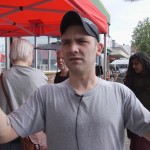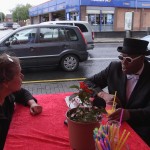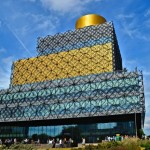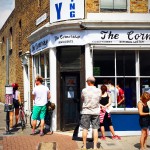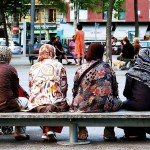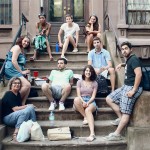MELA creates new conversations with people in Balsall Heath
MELA’s artist-led intercultural project, ‘Balsall Heath in Conversation’, has started to make a presence on the Moseley Road where people from all backgrounds are sharing their personal stories in exchange for a fresh juice. The aim of the project is to develop new relationships and networks across the diverse neighbourhood, culminating in an event that will celebrate the stories of local people and create a new intercultural meeting place on the Moseley Road. The Juice Bar was on the Moseley Road on 15th and 22nd July, and will next be seen on 23rd September.
Bridging Cultures Roundtable in Birmingham Video published
This is a short video from the Bridging Cultures Roundtable in Birmingham in April 2016 that brought together the City leader, corporates, academics, and social innovators to share their vision for Birmingham’s future as a socially cohesive city and as an inclusive place of great public spaces.
MELA wins Arts Council Grant for ‘Balsall Heath in Conversation’
Artists Ana Godinho De Matas, Sandra Hall of Friction Arts and Dan Burwood have been commissioned to create new conversations between different cultures and groups in Balsall Heath to increase social cohesion. The project ends with a big event to showcase the work and provide further opportunities for creating a new meeting place on the Moseley Road, that currently severs both sides of the neighbourhood.
Bridging Cultures Roundtable launches in Birmingham
Since the refugee crisis and the attacks in Paris and Brussels the media has been dominated by slogans of war. The portrayal of an enemy out there, separate from us, has given justification to tackle violence with violence. But in a world where there is an unprecedented cultural mixing; where people from all nations and faiths now live in the same city, the same neighbourhood, and the same street, is it possible to separate between ‘us’ and ‘them’?
Bridging Cultures is a series of roundtables calling on an alternative approach to dealing with the lack of trust between cultures. We can all be responsible for cultivating better intercultural social relations in our communities. Through better cultural understanding grievances can be handled, aspirations can be nurtured, and the benefits of intercultural creativity can be harnessed.
The roundtables are aimed at engaging with the UK’s core cities, its key organisations, and grass roots communities, to bring about a co-ordinated effort to build strong intercultural relations amongst its citizens. The first roundtable is being launched in Birmingham on 7th April and will be opened by Cllr John Clancy, Leader of Birmingham City Council. It’s a unique opportunity to bring together Birmingham’s City, Corporate and Cultural Leadership with local Social Innovators, national government and arbiters of interculturalism. The aim of the roundtable is to co-create solutions to bridging cultures in the public spaces of the city.
Cultural diversity has the potential to bring creativity to the economy that remains untapped. As cities consider ways to drive growth, Bridging Cultures provides one solution that focuses on inclusive growth – engaging all members of society to be productive and entrepreneurial. This open and honest discussion will pose the question: What social innovations can better deal with socio-cultural disadvantage, raising aspirations, and harnessing the benefits of intercultural creativity? How can the public spaces of the city be better designed to bridge cultures?
Neighbourhood Hangouts: The Place to Meet People from Diverse Cultures by Noha Nasser
People attract people. This statement was first coined by William H. Whyte in his detailed study of The Social Life of Small Urban Spaces. Whyte attributes the ‘people attraction’ behaviour to a number of factors but most surprisingly he found people ‘self-congest’. People like busy places. He observed how conversations tended to happen in places with the greatest pedestrian flows and the densest opportunities for encounter; on street corners, along main pedestrian paths, in the middle of a traffic stream, near objects like statues or fountains, along a curb. In short, people’s movements are one of the greatest spectacles of a place. People like to watch other people. People are drawn to places where other people go. It is this type of behaviour, and its location on busy pathways, that is conducive to ‘hanging out’.
What is a hang out?
What is it about places that attract people? This blog is about neighbourhood ‘hangouts’ – places where people from different cultures meet. Hangouts are meeting places. Every vibrant and cohesive neighbourhood should have a few hangouts where everyone feels welcome and can strike up a conversation with their neighbour. Sociologist Ray Oldenburg calls neighbourhood hangouts a ‘third place’; places that are for socialising and are relaxing and fulfilling. They are places that balance between domestic and work life. Oldenburg’s central thesis is that increasingly contemporary domestic life consists of isolated nuclear families or single people living alone. The work environment is similarly solitary, anti-social and competitive. Oldenburg argues people need the release and stimulation that more sociable realms provide. His term ‘third place’ signifies ‘the great variety of public places that host regular, voluntary, informal and happily anticipated gatherings of individuals beyond the realms of home and work’. Third places are often specific to cultures such as the pub in the UK, outdoor cafes in French and Italian towns, coffee houses in Austrian cities, and beer gardens in Germany. More recently, third places accommodate multiple complimentary uses that together increase footfall and attraction; for example the location of Starbucks coffee shops in bookstores.
For Oldenburg the core qualities of third places are:
- Being ‘neutral ground’, where individuals can come and go as they please
- Being highly inclusive, accessible and without formal criteria of membership
- Their ‘taken-for-granted-ness’ and low profile
- Being open during and outside office hours
- Being characterised by a ‘playful mood’
- Providing psychological comfort and support
- With conversation their ‘cardinal and sustaining’ activity, providing ‘political fora of great importance’
In every neighbourhood there are either existing places or places of potential which could be transformed into neighbourhood hangouts. These are public spaces that help bridge differences through associations and intercultural contact. The next section examines how a neighbourhood space can become a hangout.
What are the conditions for a successful hang out?
Many community-building processes are based on creating third places. Third places are most successfully created by ‘triangulation’: this simply refers to the way elements in a public place build on one another, creating something more than the sum of its parts. It is synergy. PPS calls this synergy the ‘Power of Ten’, meaning that if there are at least ten things you can do in a particular spot, it will likely become a popular destination for people in the neighborhood. As an example they describe this scenario: ‘Take a humble spot in your neighborhood – a bus stop or a branch library – and consider how you could gradually fashion it into a hub of public activity. Add a bench to the bus stop, then a trash receptacle and a drinking fountain, and it changes the whole feel of the corner. A regular Saturday morning story time, along with a community message board out front and a playground for tots, transforms the library into a community center. Then see what happens at either location when a coffee shop with sidewalk tables opens, some public art is created, and vendors arrive selling ice cream or garden produce. Voilà! You’ve got a great hangout, a place you’ll visit even when you’re not taking the bus or looking for a book. You show up because you know something will be happening there’.
In her study of the ‘superdiverse’ London Borough of Hackney, Susanne Wessendorf, describes the parochial realm. She characterizes the parochial realm by more communal relations among neighbours, with colleagues in the workplace, or acquaintances through associations or schools. What distinguishes the public realm, in her view, is that in the public realm people meet strangers, whereas in the parochial realm, like a corner shop or a market where traders and customers meet on a regular basis, social relations become habitual and frequent. The differentiation between the public, parochial and private realm is particularly useful when thinking about the degree to which interactions between people of different backgrounds are meaningful and contribute to intercultural understanding. She describes how the weekly coffee morning in the local primary school creates opportunities to socialise with people of diverse backgrounds. The mothers attending the coffee morning emphasised that having children facilitated social contacts with other parents. Conversations often focused on those shared interests like gardening, cooking and education, rather than their differences. Wessendorf concludes by saying: ‘while not talking about difference could be interpreted as a way to avoid tensions, it could also be explained with the existence of a general acceptance of people who are different and a sense that as long as people interact and are friendly, things are fine.’
Another ethnographic study of ‘Nick’s Caff’ on the Walworth Road in London by Suzanne Hall describes the importance of this meeting place to the local neighbourhood. Hall talks about the Caff as a place where ‘foreigner’ and ‘local’ sit literally and conceptually at the same table. Nick, the café owner, is a second generation migrant from Cyprus. His father opened the Caff in the 1960s, and it has become a regular and sustained institution on the Walworth Road throughout the demographic changes. Today it is a superdiverse neighbourhood. The study showed how socially organised the Caff is spatially and temporally. It allows people to claim a place to sit within the ‘rhythm of the day’. Hall records the ‘performances’ that regulate conversations, eye contact, distance, and intimacy. She notes ‘the caff was a place to go to regularly, either spontaneously or as part of a routine. It was a place where one could do nothing much without being moved on; there was no institutional setting or formal membership required for being there. One may go through the formality of ordering a cup of tea, but more importantly the Caff was a place where one could spend time and take your time.’ What both studies of Hackney and the Walworth Road show is the importance of places accommodating opportunities to linger and that provide a shared interest.
The Power of Ten concept has transformed the perceptions of public spaces. One case study is a street in New Haven where a meeting place was created by a savvy developer, Joel Schiavone. Chapel Street in the downtown of New Haven, Connecticut, had by the 1980s suffered severe urban decline with only five percent of the area’s residential and commercial spaces being occupied. Schiavone was inspired to invest in a number of small interventions without making the street look radically different. He convinced city officials to undo the damage of an earlier street-widening project by expanding the pavements so that Chapel Street felt like a place you’d want to hang out. As a result, a café expanded with outdoor seating, then two more cafés opened, and a newspaper vendor set up shop. Today, Chapel Street is thriving, a hub for people to use the place throughout the day and week. As a result of uses that began to attract footfall, other establishments began to have confidence in opening up leading to the opening of nightclubs, restaurants, several theatres, and shops selling everything from bicycles to jewelry. ‘The whole thing is like a mosaic,’ Schiavone explains. ‘Each piece needs to be carefully considered: street furniture, flowerboxes, a particular tenant for a storefront, tree plantings. If it’s done right, all these things come together to create a real neighborhood.’
Noha is author of the book ‘Bridging Cultures: the guide to social innovation in cosmopolitan cities’ available on Amazon at http://www.amazon.co.uk/Bridging-Cultures-Social-Innovation-Cosmopolitan/dp/1517157188
Reversing Prejudice: How public spaces can dispel myths of the ‘other’ by Noha Nasser
Why People Don’t Get Along
For many global cities and global societies inequalities are rooted in prejudice. It is the fundamental way in which people make sense of the world around them. People mentally organise different groups of people into categories. It is a way to reinforce their group privilege over another. Invariably, prejudice results from a fear of strangers or feelings of superiority over others. It is formed by an attitude towards a particular social group based on incomplete or mistaken information. Generalisations, oversimplifications, and stereotyping about a group based on prior assumptions can lead to faulty beliefs. It leads to discrimination and inequality. These inequalities can be experienced in the segregated spaces of the city as discussed a few blogs ago. Without understanding the nature of prejudice, any community engagement process will be doomed to failure. If we are to co-design public spaces for people to bridge between cultures, we need to understand the inherent ways people understand the ‘other’ so that these myths can be dispelled effectively before building a shared sense of place and co-designing a public space.
Some of the most well-known types of prejudice include racism, sexism, homophobia, nationalism, religious prejudice, and agism. A negative prejudice is when the attitude is hostile toward members of a group. A positive prejudice is when the attitude is unduly favorable toward a group. Groups that are the targets of prejudice may be distinguished by any one of several characteristics. Religion, ethnicity, language, social class, gender, physical abilities, age, or sexual orientation are forms of prejudice. Frequently they are distinguished by specific inherited physical characteristics such as skin colour. The way in which people categorise information tends to minimize differences between people within groups. The information exaggerates the differences between groups. People also tend to view members of ‘outside groups’ as being more homogenous than members of their own group, a phenomenon referred to as the ‘out-group homogeneity bias’. This perception that all members of an out-group are alike holds true of all groups, whether based on race, nationality, religion, age, or other naturally occurring group affiliation.
Prejudice is such a basic part of a person’s complex thought process that any one of many causes may be a factor. A person’s appearance or unfamiliar social customs of others may be factors. Prejudice exists not only at the personal individual level, but also at the collective societal level. All human societies have prejudice in some form and to some degree. In fact many societies have multiple prejudices both at the individual and group levels, therefore determining the cause of prejudice in any single person is difficult. Most people do not willingly reveal their prejudices or the reasons for them, if they are even aware of their prejudices at all. Some people may have become prejudiced through some traumatic event they experienced in their lives. Others are simply conforming to the society in which they live, expressing the same prejudices as parents, popular political leaders, employers, or the media.
As there are many causes of prejudice, there can be many forms of prejudicial expression, the most common of which is discrimination. Discrimination is the unfair treatment of people simply because they are different from the dominant group in society. Prejudice and discrimination cause inequality especially when minorities are readily identified.
Reversing Prejudice through contact
One of the basic rationales is that prejudice may be reduced as one learns more about different cultures. Placing people into contexts where they become more empathetic to members of other cultural groups is one method that has shown considerable success in reversing prejudice. By imagining themselves in the same situation, people are able to think about how they would react and gain a greater understanding of other people’s actions.
A number of hypotheses exist that examine the nature of inter-cultural relations. The most widely accepted is Allport’s ‘contact hypothesis’ based on the reconceptualization of cultural group categories. This approach reconceptualises ‘in-groups’ and ‘out-groups’ in a way that constructs collective categories to which people belong. It reduces prejudice and promotes positive attitudes towards the out-group under certain conditions. Allport claims that when people are given an opportunity to communicate with others, they are able to understand and appreciate different points of views involving their way of life. The key is to manage this communication and mediate any conflicts. Allport identifies 5 conditions for positive contact:
- Equal status: Both groups must engage equally in the relationship. Members of the group should have similar backgrounds, qualities, and characteristics. Differences in academic backgrounds, wealth, skill, or experiences should be minimized if these qualities will influence perceptions of prestige and rank in the group.
- Common goals: Both groups must work on a problem/task and share this as a common goal, sometimes called a ‘superordinate goal’, a goal that can only be attained if the members of two or more groups work together by pooling their efforts and resources.
- Intergroup cooperation: Both groups must work together for their common goals without competition. Groups need to work together in the pursuit of common goals.
Support of authorities, law or customs: Both groups must acknowledge some authority that supports the contact and interactions between the groups. The contact should encourage friendly, helpful, egalitarian attitudes and condemn in group-out group comparisons.
Personal interaction: The contact situation needs to involve informal, personal interaction with out group members. Members of the conflicting groups need to mingle with one another. Without this criterion they learn very little about each other and cross-group friendships do not occur.
The interaction cycle takes a more psychological needs approach to understanding the conditions for positive contact based on a person’s familiar internal world, their identity and values, as well as the unfamiliar interactions that lead to wider benefits:
- Grounding: interactions with close and familiar people that help confirm and consolidate a person’s identity and values
- Strokes: interactions with familiar but less close people that consolidate a person’s confidence as a member of a wider group
- Opportunity: interactions that open up to new people and that might lead to benefit for the person and for the other person
- Growth: interactions that open a person up to new people and that through discussion, debate and learning lead to the person achieving a new and enhanced understanding of the world to the extent that their identity and values are changed
Other theories for intercultural relations include the ‘opportunity hypothesis’. It contends that the occurrence of cross-cultural friendships increases as the opportunities for them increase in contexts like multicultural schools. When the proportion of minorities increases, or where there are several groups present, the opportunity to form cross-cultural friendships increases significantly.
In contrast there are theories that identify why people would not interact. ‘Similarity-attraction hypothesis’ claims individuals are more likely to prefer to seek out people with whom they share salient characteristics. The ‘culture-distance hypothesis’ predicts the greater the cultural gap between people the more difficulties they will experience interacting. Another theory is based on ‘civility towards difference’ where people may be offended by differences in physical abilities, beauty, skin colour and hair texture, dress style, demeanour, income, sexual preferences, etc., but will act in a civil manner. This form of appreciation of diversity is based on treating people universally the same. It can emerge from indifference to diversity rather than from specific appreciation of it. Others caution against the positive effects of regular contact in improving intercultural understanding and shifting prejudiced perceptions. Indeed, some studies have shown that stereotypes and racism towards cultural diversity can co-exist with daily interactions in diverse neighbourhoods.
In his detailed study of the cause of the Bradford Riots, Ted Cantle was the first to claim how different cultures were living parallel lives. He identified five forms of interactions that measured the health of cross-cultural relationships:
- Intra-associational: integrated and multiple identity. Associations are open to people of different backgrounds and facilitate interchange and cooperation within the organisation, and promote social cohesion
- Inter-associational: networked single identity. Associations represent separate and distinct interests on an inclusive and single identity with associations formed by networks of separate bodies and which is less desirable for social cohesion
- Social incidental: arising from everyday activities. Interaction between individuals meeting through shopping, traveling or leisure activities, at an individual level, with organisation
- Social organisational: arising from planned and organised activity. Interaction by participating in sporting, music, drama and arts, which involves group activities, generally organised around clubs and societies and desirable for bridging capital
- Structural cross-cultural contact: This will depend upon the extent to which schools and housing are segregated, employment opportunities are linked to particular groups, and market factors create divisions which militate against cross cultural engagement. The greater the segregation, the weaker the social cohesion
Promoting Values for Bridging Cultures
Several commentators have suggested that it is the horizontal relationship between citizens, residents and local people with each other at the scale of the neighbourhood which creates a wider sense of common interest. People need to share things in common in order to live together. Several factors, in particular, are critical:
- Trust: people must trust one another to comply with the rules
- Solidarity: people must still recognise the value of contributing to the common good even when they don’t directly benefit as a result
- Empowerment: People feel they have a voice which is listened to and are involved in processes that affect them. They have the power to take actions and initiate change themselves
- Participation: people take part in social and community activities
- Associational activity and Common purpose: people co-operate with each other through the formation of formal and informal groups to further their interests
- Supporting networks and reciprocity: People and organisations co-operate to support one another for either mutual or one-sided gain. An expectation that help would be given to or received from others when needed
- Collective norms and values: people share common norms and values. They tolerate and respect other people’s norms and values.
- Safety: people feel safe in their neighbourhood and are not restricted in their use of public space by fear
- Belonging: people feel connected to their neighbours and place
We know that public spaces are vitally important for that, because they are where people often encounter one another. These values, such as trust and solidarity, are often built partly through familiarity. The gradual breaking down of the barriers of ‘otherness’, and the recognition of shared interests and a common humanity between strangers builds familiarity over time. For the same reason, the places where people interact with the state plays an essential part in building people’s trust in the state. When it comes to diversity and change, particularly in communities which are experiencing tensions and rapid rates of mobility, trust becomes an essential element for building relationships.
Unveiling the Muslim Headscarf: women, citizenship and public space
In 2006, a heated debate flared up after Jack Straw, ex-foreign secretary and MP for Blackburn, had asked a Muslim woman to remove her veil while she was sitting in his constituency office. Over the past decade, the veil has been used as a persistent symbol of female oppression and lack of integration in European society. What didn’t occur to Jack Straw and commentators at the time, was that this veiled Muslim woman was in fact exercising her democratic right to consult with her MP, and in his public office.
The division between public and private space, both physically and legally, is about understanding the extent to which an act or behaviour affects society as a whole. Public space and public law governs the relationship between the person and the state, and private law governs the relationships of individuals. In Islam, and particularly for Muslim women, the distinction between public and private spheres of life is very important. In the private spheres of life, that is in the home, the veil is not worn. Women can freely mingle with male members of the family household with which they are directly related. However, in the more public spheres of life, including in the more public zones of the home and the city, the veil allows for women to freely engage with society as if she was in a private space.
In my workshops engaging with Muslim women in the design of their home, we collaboratively produced a design brief based on their cultural values. Women spoke of the importance of the kitchen and back rooms as spaces for family gatherings. For them, the front room, played a similar role to the traditional English parlour, a place to greet guests. This back and front divide is a representation of the private/public space divide. To extend a woman’s freedom to actively socialise with people not related to her, the headscarf and veil offer her the scope to be visible in society. The Muslim woman sitting in Jack Straw’s office was precisely making that point. She had left the private sphere of her home to participate democratically in society. To be asked to ‘look a certain way’ was to diminish her freedom of choice and self-expression, and to not acknowledge her presence in a democratic and public space.
A lot can be said of the interpretation of the veil and headscarf in British society as an impingement on public law, and by extension the relationship of Muslim women and the state. The recent remarks by the Prime Minster claiming that 22% of Muslim woman speak little or no English is a sign of segregation, substantiates the common portrayal of the victimised Muslim woman. However, when speaking to Muslim woman directly, their experience is very different. For these women the headscarf and the veil is a symbol of their piety, modesty, autonomy in public space, and freedom of self-expression. The question is do these 22% of women find a need to speak the language? I would argue that the lack of acceptance and hospitality rife in British society, because of the commonly-held misperceptions, has forced Muslim women to remain within their communities.
In my book, Bridging Cultures, people who prefer to network with people like themselves do so because there is scope for mutual social, emotional and economic support. Many of these Muslim women work in family businesses and support the family in the home. I recognise the value of this form of networking, or bonding capital, for the well-being and sustainability of a minority culture. Nonetheless, I also argue for bridging capital, where social networks are built between cultural groups. However, for bridging capital to exist, there are certain conditions that support it. For one, there has to be a dispelling of myths and prejudices that seek to alienate segments of our society on the grounds ‘they don’t look or behave the same’. Liberal democracy is about respect for other cultures and religions. To uphold one of the core principles that of diversity: it means we show respect for difference. A fair and just society for all is built upon the foundation of upholding the rights of others even if we disagree with, or dislike the choices that they may make. This means if women can chose to wear as little as they like then they should also be able to choose to wear as much as they like. Like other women, Muslim women should also have the independence to choose to wear what they want.
Another condition is the acceptance, respect and tolerance required for all members of society to co-exist in the public spaces of the city. All members have equal right to be present and access public spaces without fear of judgment or denial of legitimacy. In my opinion, for Muslim women to integrate into British society, British society would need to integrate Muslim women by recognizing them as equal citizens, capable of finding ways to occupy public spaces and exercise their rights with freedom and ease.
Social Cohesion and Public Space by Noha Nasser
The negative perceptions of others, prejudice and racism break down social interaction in public space. The aim of this blog is to discuss the role of public space to bring about greater social cohesion. One commentator, Ash Amin, argues that public open spaces in cities are unlikely to encourage ‘inter-ethnic understanding’ because they are not ‘spaces of inter-dependence and habitual engagement’. Rather, he suggests, people are more likely to come to terms with ethnic differences in places of more regular association such as the workplace, schools, youth centres and sports clubs ‘where dialogue and ‘prosaic negotiations’ are compulsory’. Amin argues that it is the places in which we are obliged to be, combined with the opportunity or incentive for ‘banal transgressions’, which displace us from one cultural space into another, where new intercultural sociability is being formed.
Similarly, Stephen Vertovec emphasises the importance of such ‘everyday practices for getting-on with others in the inherently fleeting encounters that comprise city life’. He uses the term ‘civil-integration’ in contrast to the ‘deep and meaningful’ encounters that he feels are unlikely to occur regularly in the context of super-diversity. Amin states that public space, in its widest sense, can be an operating mode for generating a kind of studied trust in urban multiplicity and public acceptance of ‘thrown togetherness’. The acquiring and routinisation of civil-interaction to Vertovec includes ‘simple forms of acknowledgement, acts of restricted helpfulness, types of personal consideration, courtesies, and ‘indifference to diversity’. He argues, that these kinds of daily civility should be negotiated and promoted alongside wider ambitions for better relationships.
While relationships between community integration and public open spaces are not reducible to simple mechanisms, consideration of social processes is important. Intercultural understanding can illuminate the indirect role played by such spaces. Positive perceptions of public spaces, such as shopping streets, contribute to people’s decisions to stay in the area. Long-term residence and regular interaction in neighbourhood spaces have a positive influence on intercultural relations; attitudes to difference among varied groups of neighbours is improved. Therefore, the continuity of social relations over time, and the endurance of the spaces that support them is vital to building trust. With trust comes solidarity, and the growing of shared meanings and values.
According to Landry and Wood, there are key public institutions where conditions can be created for interactions without forcing actions. They claim these spaces have ‘strategic intent, careful planning, and skilled intervention to transform avoidance and indifference into engagement and co-operation’. In their view, places like museums, libraries, sports, the arts, and computer-mediated communication can be pre-disposed to being intercultural. This is because they are ‘programmed’ in light-touch ways to build on shared interests, common curiosities, active debate, disagreement, mediation and resolution. They serve to displace people from their cultural moorings, just enough for them to begin to see the world through the eyes of another, without forcing them onto the defensive.
In their study of Newham, a diverse borough of East London, Dines and Cattell illustrate that certain public spaces support culturally-based networks and promote a sense of pride. A key factor is how these spaces are perceived and valued. Unstructured cultural interactions provide experience and increase tolerance because they are unthreatening. They are spaces that harness the potential for maintaining and improving inter-cultural relations as sites where people, under the right circumstances or with the necessary encouragement, might come together. As everyday settings they offer a wide range of interests and attachments to place.
Dines and Cattell highlight the importance of key spaces that were valued by different cultures, including:
- Queens Market – a bustling, jostling market, which facilitated casual exchange and encouraged encounters between different cultural groups who would otherwise not come into contact with each other. It was generally recognised as a setting for developing tolerance.
- Green Street was known as the ‘Asian’ street; a busy shopping street that played a positive role in promoting place identity, a sense of pride, and supporting cultural networks, but not necessarily for promoting new intercultural encounters.
- A small neighbourhood park adjacent to a primary school, where meetings between parents in the welcoming lobby of the school led to greater shared use of the neighbouring park . Together, the school and the park had helped to bring different communities together
- Younger, single, Asian informants enjoyed visiting the West End and other places such as the shisha bars on Edgware Road, partly as a form of escape from their ‘community’ but mainly because such places offered opportunities for social encounters and experiences that the local area did not provide.
- Neighbourhood and semi-domestic spaces, such as residential streets and shared forecourts for houses and flats provided the first point of contact with neighbours of different cultures. Echoing a practice once common to the East End, when sitting by the front step was a popular form of sociability, a white British woman had got to know her Asian and African Caribbean neighbours by sitting with her friend out on her front drive. A black British man who lived in a small block of flats had first encountered his white neighbours on the green space in front of the block. A Pakistani woman, who thought it simpler and safer to stay with one’s cultural or religious group, nevertheless suggested that her habitual use of neighbourhood spaces over time was an instrumental factor in good relations with her largely white neighbours.
- The exchange of food was an important means for establishing and maintaining ties between different residents. People also indicated the key role that children played in drawing families together, which led to continued contact in local spaces.
- Informal games and sports in the neighbourhood park were seen by some residents as the principal means of encounter between young people.
- The new community centre provided reasons for contact and exchange across potential cultural divides
- Spaces of association, such as clubs or groups based around communities of interest provided key sites of engagement such as a day centre where the Albanian and Bosnian women could speak to compatriots but also where they were able to meet and work alongside people of different origins, such as Lithuanians, Pakistanis and Somalis
- A Sikh temple off Green Street was used by the market campaign group for its public meetings. This was seen as an open, welcoming space. However, the relationships consolidated between people during these meetings were often initiated in the market itself and later fostered through their collective mobilisation over public space.
What this study shows is that those public spaces perceived to be of value gave diverse people the choice to undertake different degrees of ‘togetherness’ in the context of everyday, ordinary, routine activities. They were motivated by different needs. Most of all, the study emphasises that interaction can never be forced or false. It takes time to achieve familiarity as it is about people’s habits in their public behaviour. It is the potential of these everyday spaces that needs to be harnessed. Their daily movements and interactions should be enjoyable and stimulating. Therefore, any spatial interventions should be about improving the conditions and circumstances for these intercultural interactions to take place. For example; improving the physical conditions at the school gate or bus stop to widen pavements, or adjusting a market’s management regime. These are both interventions that take small steps, and start with people’s existing behaviour and preferences.
Feeling safe and secure in a space is a vital precursor to fostering trust and encouraging new uses. Signs of crime and vandalism communicate disrespect and lack of care for residents. Until these are tackled, interventions aimed at more sophisticated integration goals will have only limited success.
There is also a policy dimension. Policies can encourage greater intercultural encounters in public space to support feeling safe and secure. One of the most innovative policy developments in recent years has been the Intercultural Cities Index. It is a tool developed by The Intercultural Cities Programme on behalf of the Council of Europe. They promote the adoption of city-wide Intercultural Policy, including intercultural public space policies. Phil Wood, consultant to the Intercultural Cities Programme, has written about the degree to which intercultural public space policies have been implemented in European cities. He shows correlations between residents’ feeling of safety in the city and the adoption of intercultural space policies. What he reports is those cities are safer cities compared to those that do not have policies. There are exceptions to this rule, however. Wood argues that the empirical evidence from the Intercultural Cities Index suggests that policies that support the maintenance of open, safe, attractive and intercultural public spaces have localised benefits and positive effects on city performance.
Policies can also support the emergence of new communities or their continuous adaptation. Through spatial or activity-based interventions, local communities can be connected. They can open up and friendships can be established. In some neighbourhoods this has included the establishment of a joint vegetable gardening club, collective recycling, participation in neighbourhood radio or television channels. Exchanges occur between institutions or groups such as schools and theatres as well. These types of activities can lead to the sharing of concern and the creation of new networks of social capital. The focus is on citizen-led community-building approaches. Social innovation in public spaces galvanizes the public to get involved. Civic action around issues of common interest, provides the emotional and intellectual outlets needed to help people form better relationships. Several commentators stress the importance of civic action. Landry and Wood, in particular, write extensively on the Intercultural Practitioner for which they list a new skills set:
- Cultural competence – the ability to reflect upon one’s own culture and the culture of others
- Emotional and spiritual competence – the ability to be self-reflective, handle one’s own emotions, empathise with others
- Linguistic and communicative competencies – the ability to listen to people, their stories, and to translate their aspirations into expert systems
- Civic competence – the ability to understand and act upon rights and responsibilities and be socially and morally responsible
- Creative competence – the ability to find different creative mediums for communities to express themselves
Policy-makers and practitioners working in diverse areas, and particularly when designing and managing public space, need to balance the seemingly contradictory cultural priorities of different communities. How are their different cultural values reflected in public spaces? In a report commissioned by the Commission for Racial Equality, Lownsbrough and Beunderman conclude four key recommendations:
- be flexible in the use of space, understand the grain of people’s everyday lives and reflect it in the design of public space
- aim to create the setting for ‘trusted’ spaces, where people feel secure to take part in unfamiliar interactions
- foster positive interactions but don’t promote them: take an indirect approach to changing behaviour
- embrace creativity and innovation in finding new and imaginative uses for spaces that will transform interactions between people
The focus is clearly not on the design challenges of public spaces alone. As we know, cosmetic interventions in public space such as new paving, elegant street furniture and improved lighting alone do not encourage underperforming public spaces. Businesses fail, traffic dominates and anti-social behavior takes place in these spaces. What an intercultural approach to public space requires is that people are given the voice and opportunity to develop a shared future. Each individual feels they have something to contribute in shaping, making, using, and co-creating a shared space.
Conflict in Public Space by Noha Nasser
In my book ‘Bridging Cultures: the guide to social innovation in cosmopolitan cities’ I focus on how public spaces can provide opportunities for social encounters and cross-cultural exchanges. Yet we all know that public space is also contested. The recent London riots that spread nationwide in 2011 was a clear demonstration of angry youths taking to the streets to protest. On the news, we hear about gangs fighting over territories. Youths create social and economic solidarity in response to their marginal positions in society. In the post 9/11 world we are acutely aware of hyper security and surveillance. It limits our movement and freedom of self-expression. We also know that public space has increasingly excluded certain groups of people in society. Skateboarders, the homeless, poor people who can’t afford the café culture, women, children, prostitutes are some of the excluded groups. Therefore contrary to popular belief that public space is democratic, open and inclusive, public space is also politically, socially and economically biased.
In many instances, public spaces are regulated by unofficial rules established by those in perceived power (‘white’ people in the case of the UK). The perceived superiority between different groups of people is at the root of many conflicts in public space. Racism and prejudice play a significant role in breaking down social interaction. They are based on myths and stories people have of others. The unconscious breaking of rules – the parking of a car in the wrong space, the inattentive disposal of rubbish, the lack of care for a front lawn – lead to people being ostracised or sometimes harassed. These unwritten rules and social norms not only serve to maintain a sense of order but are often used to legitimise prejudices against certain groups on cultural rather than racial grounds. For cultural minorities, public spaces can make them feel excluded because of additional deterrents created by unfamiliarity and fear of hostile or discriminatory behaviour. Such fears are corroborated and reflected in the 2003-04 crime figures which show, for example, that there were 4,179 prosecutions for racially aggravated crimes, of which 1,056 were assaults or harassment.
These types of conflicts tend to happen in the residential areas where there is a clearer distinction between ‘insiders’ and ‘outsiders’ than in places such as the general market where there is a greater sense of ownership over space. The perceived intrusion of outsiders could lead to tensions. In resolving issues of racism and prejudice, a raised awareness of different cultural norms and more open conversations are required.
Other forms of prejudice against young people is a recurring theme. Today, Anti-Social Behavior Orders against young people represent the mistrust adults have of young people ‘hanging out’. With most young people spending their time in public space, this creates tensions. Some adults perceive large numbers of youths as a threat and avoid or tolerate them, whereas others take a more confrontational stance. The perception that young people are ‘trouble makers’ is largely down to the negative stereotyping that has defined neighbourhoods. The ‘reputation effect’ is exacerbated by the limited experience and mobility of people outside their own neighbourhoods. So while decrying some areas as being unsafe, external observers are projecting irrational opinions on neighbourhoods. These irrational ‘beliefs’ have proven to lower life chances. Many commentators point to the structural inequalities that face young people today as the root cause to much of the neighbourhood-based ‘gang turfs’. In itself, turfs are not necessarily racially focused – often it is merely an expression of neighbourhood attachment taken to an extreme. To a degree, turfs should be recognised as an inherent aspect of young people’s lives. It only becomes problematic in combination with other forms of deprivation and negative behaviour. Neighbourhood gangs as well as segregated communities are thus examples of the danger of ‘bonding social capital’ of the wrong kind. Too much belonging leads to the creation of clear turfs and psychological boundaries. In resolving conflicts, therefore, issues of inequality and marginalization require addressing.
To counter the preconceived opinion that is not based on reason or actual experiences between people of different races, cultures, genders, sexuality and generations, the need for openly talking about differences is required. This will open up a space for resolving conflicts. Greater cross-cultural understanding will result. It is also an opportunity to address some of the underlying structural issues that lead to conflict, many of which are related to economic marginalization and access to resources. It’s a good place to start a conversation.
Spatially, access to housing, public space and community facilities are key urban resources. In many regeneration schemes and housing estate improvements, new development is inward-looking. Facilities are centrally located. Housing is separated according to socio-economic incomes. Richard Sennett describes the failure of a project in which he was involved in. He speaks about how ‘boundary thinking can miss opportunities’. Tasked with the creation of a new market (La Marqueta) in Harlem, New York; ‘we planners chose to locate La Marqueta in the centre of Spanish Harlem twenty blocks away, in the very centre of the community, and to regard 96th Street [where Harlem changes into a very wealthy area – the Upper East Side] as a dead edge, where nothing much happens. We chose wrongly. Had we located the market on that street, we might have encouraged activity which brought the rich and the poor into some daily commercial contact. Wiser planners have since learned from our mistake, and on the West Side of Manhattan sought to locate new community resources at the edges between communities, in order to open the gates between different racial and economic communities. Our imagination of the importance of the centre proved isolating, their understanding of the value of the edge and border has proved integrating.’
This is by no means easy. The problem with segregation and zoning is exactly its entrenchment and embedding in daily routines, as well as mental maps. Other examples include transport links that provided invaluable access for poorer residents on the outskirts of cities. Transport provides access to resources and services in the commercial centre. The point is that spatial layout and access to resources, such as public space, are fundamental to blurring the boundaries of inequality.


